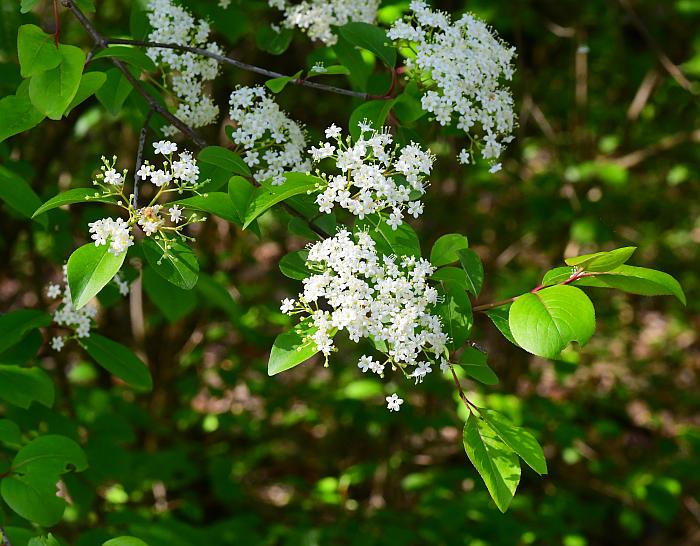Viburnum prunifolium L.
Blackhaw

Native
CC = 4
CW = 3
MOC = 82
© SRTurner
Viburnum prunifolium L.Blackhaw | |
 |
Native CC = 4 CW = 3 MOC = 82 |
© SRTurner |
|
Family - Caprifoliaceae Habit - Shrub or small tree to 5 m tall. Stems - Bark firm, not peeling, relatively smooth to finely roughened or warty on younger branches, sometimes forming small plates or furrows on older trunks, gray to grayish brown. Winter buds oblong-conical, often somewhat flattened, with a pair of scales, these valvate (the margins touching but not overlapping), glabrous or with scattered, minute, red to reddish brown, stellate hairs, somewhat sticky. Twigs glabrous.
Leaves - Opposite, petiolate. Stipules absent. Petioles 8-16 mm long, with poorly to moderately well-developed wings 0.2-1.0 mm wide flanking the ventral groove, especially toward the tip, these straight, glabrous or with scattered microscopic, red to reddish brown, stellate hairs, lacking prominent glandular swellings near the tip. Leaf blades 1.5-8.0 cm long, 1.0-4.5 cm wide, unlobed, relatively thin and papery, broadly to less commonly narrowly elliptic to oblong-ovate, rounded to short-tapered at the base, rounded or broadly angled to a usually bluntly pointed tip, or contracted to a short-tapered, sharply pointed tip, the margins finely toothed with the teeth 5-11 per cm, numerous on each side, the surfaces glabrous or with scattered microscopic, red to reddish brown, stellate hairs when young, pinnately veined, the secondary veins evenly spaced, curved or arched toward the tip, looping and joined with adjacent veins into a network, not reaching the margin. Adaxial surfaces not highly glossy.
Inflorescence - Terminal, dense, flat-topped or slightly domed panicles, appearing as compound umbels, sessile or short-stalked, usually with 4 primary branches, these glabrous or with scattered microscopic, red to reddish brown, stellate hairs, the marginal flowers fertile and similar to the other flowers.
Flowers - Calyx tube to 2 mm long, 1.2 mm in diameter, glabrous, 5-lobed, the lobes to 0.5 mm long. Corolla whitish, 5-lobed, to 9 mm broad, the lobes rounded, 3 mm long and wide. Stamens 5, borne at base of corolla tube, strongly exserted, erect. Filaments to 4 mm long, glabrous. Anthers yellow, to 1.2 mm long. Style thick, 0.7 mm long.
Fruits - Berrylike drupes 7-16 mm long, ellipsoid, oblong-ovoid, or nearly spherical, bluish black, slightly glaucous. Nutlet 9-15 mm long, yellowish brown to dark brown.
Flowering - April - May. Habitat - Bottomland and mesic forests, streambanks, bases and ledges of bluffs, fencerows, pastures, railroads, and roadsides. Also cultivated. Origin - Native to the U.S. Other info. - This species can be found throughout Missouri except for a few counties in the extreme northwest corner of the state. It occurs throughout most of the eastern half of the continental U.S., infrequently in the far southern states. The plant can be identified by its opposite, broadly elliptic and finely toothed leaves, its tan, thin leaf buds, and its showy clusters of white flowers. The leaf petioles lack the dense red hairs which are present on petioles of V. rufidulum (although a few may be present). Photographs taken at the Kansas City Zoo, 10-12-99, at Whetstone Creek Conservation Area, Callaway County, MO., 2-26-04, and off the MKT Trail, Columbia, MO., 4-23-04 (DETenaglia); also at Babler State Park, St. Louis County, MO, 4-24-2020 (SRTurner). |